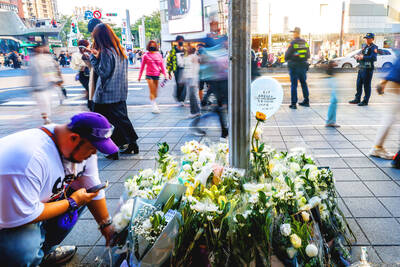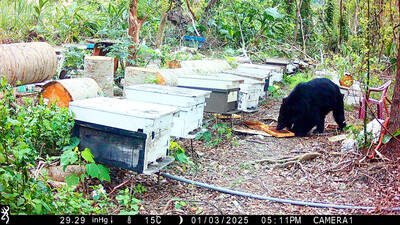Taiwan yesterday joined the US in expressing “deep concerns” over a security pact sealed a day earlier between China and Taipei’s former diplomatic ally the Solomon Islands, a move that many fear could open the door to a Chinese naval base in the South Pacific.
“We share the same stance [as] our democratic allies in expressing concerns over the lack of transparency in a deal that could destabilize regional peace and security,” Ministry of Foreign Affairs spokeswoman Joanne Ou (歐江安) said.
The deal could also threaten a “supply chain between diplomatic countries,” she said, referring to some experts’ concerns that Beijing’s establishment of bases across the Pacific could threaten US supply lines in the event of war.

Photo: Screengrab from Learn & Study in Taiwan website
She called on the Solomon Islands not to become a “bargaining chip” or assist Beijing in expanding its military presence in the Pacific region.
“Taiwan will continue to work together with like-minded nations to maintain peace, stability and a rules-based international order in surrounding regions,” she added.
The Solomon Islands had been Taiwan’s diplomatic ally since 1983. The two countries cut diplomatic relations in September 2019 after Honiara announced it would ditch Taipei in favor of Beijing.
Chinese Ministry of Foreign Affairs spokesman Wang Wenbin (汪文彬) announced the signing of the security agreement in Beijing on Tuesday evening, saying it would involve China cooperating with Honiara on maintaining social order, protecting people, providing aid, combating natural disasters and safeguarding national security.
However, the US has said that the pact could lead to a Chinese military presence in the Solomon Islands, and Australia and New Zealand are wary of China’s growing influence in a region traditionally under their sway.
The US Department of State on Monday said that the pact “leaves open the door for the deployment of PRC [People’s Republic of China] military forces to the Solomon Islands” and sets a “concerning precedent for the wider Pacific island region.”

SHIPS, TRAINS AND AUTOMOBILES: The ministry has announced changes to varied transportation industries taking effect soon, with a number of effects for passengers Beginning next month, the post office is canceling signature upon delivery and written inquiry services for international registered small packets in accordance with the new policy of the Universal Postal Union, the Ministry of Transportation and Communications said yesterday. The new policy does not apply to packets that are to be delivered to China, the ministry said. Senders of international registered small packets would receive a NT$10 rebate on postage if the packets are sent from Jan. 1 to March 31, it added. The ministry said that three other policies are also scheduled to take effect next month. International cruise ship operators

HORROR STORIES: One victim recounted not realizing they had been stabbed and seeing people bleeding, while another recalled breaking down in tears after fleeing A man on Friday died after he tried to fight the knife-wielding suspect who went on a stabbing spree near two of Taipei’s busiest metro stations, Taipei Mayor Chiang Wan-an (蔣萬安) said. The 57-year-old man, identified by his family name, Yu (余), encountered the suspect at Exit M7 of Taipei Main Station and immediately tried to stop him, but was fatally wounded and later died, Chiang said, calling the incident “heartbreaking.” Yu’s family would receive at least NT$5 million (US$158,584) in compensation through the Taipei Rapid Transit Corp’s (TRTC) insurance coverage, he said after convening an emergency security response meeting yesterday morning. National

PLANNED: The suspect visited the crime scene before the killings, seeking information on how to access the roof, and had extensively researched a 2014 stabbing incident The suspect in a stabbing attack that killed three people and injured 11 in Taipei on Friday had planned the assault and set fires at other locations earlier in the day, law enforcement officials said yesterday. National Police Agency (NPA) Director-General Chang Jung-hsin (張榮興) said the suspect, a 27-year-old man named Chang Wen (張文), began the attacks at 3:40pm, first setting off smoke bombs on a road, damaging cars and motorbikes. Earlier, Chang Wen set fire to a rental room where he was staying on Gongyuan Road in Zhongzheng District (中正), Chang Jung-hsin said. The suspect later threw smoke grenades near two exits

The Forestry and Nature Conservation Agency yesterday launched a gift box to market honey “certified by a Formosan black bear” in appreciation of a beekeeper’s amicable interaction with a honey-thieving bear. Beekeeper Chih Ming-chen (池明鎮) in January inspected his bee farm in Hualien County’s Jhuosi Township (卓溪) and found that more than 20 beehives had been destroyed and many hives were eaten, with bear droppings and paw prints near the destroyed hives, the agency said. Chih returned to the farm to move the remaining beehives away that evening when he encountered a Formosan black bear only 20m away, the agency said. The bear